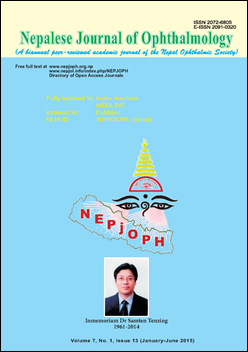A new combined surgical approach in a patient with microspherophakia and developmental iridocorneal angle anomaly
DOI:
https://doi.org/10.3126/nepjoph.v7i1.13178Keywords:
microspherophakia, developmental iridocorneal angle anomaly, pars plana vitrectomy and lensectomy, goniotomyAbstract
Backround: We describe a patient with microspherophakia due to Weill-Marchesani syndrome accompanied by developmental angle anomaly who was successfully treated with a surgery of combined PPL and goniotomy.
Case: We report ocular findings of a 1-year-old girl who was diagnosed with Weill-Marchesani syndrome with a positive family history of glaucoma in her cousins and glaucoma with anterior segment dysgenesis in her older brother. Anterior segment examination revealed clear corneas with 13 mm horizontal diameter in the right and 12.5 mm in the left and very shallow anterior chambers centrally and peripherally in both eyes. Although axial lengths were 18.9 mm in the right and 19.1 mm in the left eye, cycloplegic refractive errors were -7.75 DS (-2.75 at 1800) in the right eye and -8.50 DS (-2,75 at 1800) in the left eye. Intraocular pressures were 34 mmHg in the right and 38 mmHg in the left eye.
Observation: Following pars plana lensectomy, gonioscopy revealed developmental iridocorneal angle anomaly and goniotomy was performed at the same session. During 3 years of follow-up, the patient experienced no complications. IOP was 12 mmHg without medication in the last visit; cup-to-disc ratio and corneal diameters were stable.
Conclusion: The coexistent microspherophakia and developmental iridocorneal angle anomaly can be successfully treated with combined pars plana lensectomy and goniotomy.
Downloads
Downloads
Published
How to Cite
Issue
Section
License
This license enables reusers to copy and distribute the material in any medium or format in unadapted form only, for noncommercial purposes only, and only so long as attribution is given to the creator.




